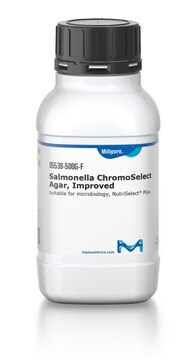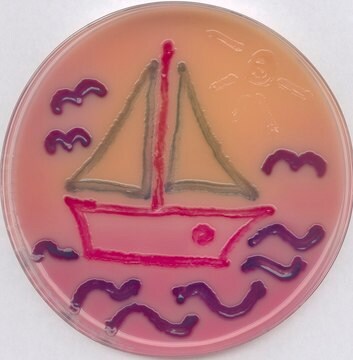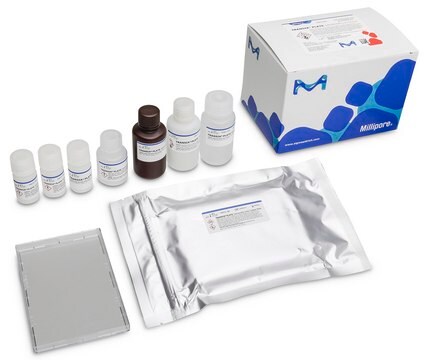Wichtige Dokumente
01993
Salmonella-Chromogen-Agar-Set
suitable for microbiology, NutriSelect® Basic
About This Item
Empfohlene Produkte
Form
powder
Qualitätsniveau
Haltbarkeit
limited shelf life, expiry date on the label
Hersteller/Markenname
NutriSelect® Basic
pH-Wert
7.3±0.2 (25 °C)
Anwendung(en)
clinical testing
environmental
food and beverages
microbiology
Lagertemp.
2-8°C
Eignung
nonselective and differential for Escherichia coli
nonselective and differential for coliforms
selective and differential for Escherichia coli
selective and differential for Klebsiella spp.
selective and differential for Proteus spp.
selective and differential for Salmonella spp.
selective and differential for Shigella spp.
selective and differential for coliforms
selective and differential for enterobacteriaceae
Anwendung
Komponenten
Pepton 5g/l
Hefeextrakt 2g/l
Fleischextrakt 1g/l
Natriumchlorid 5g/l
Natriumdeoxycholat 1g/l
Agar 15g/l
4 Vials Supplement (Fluka 38589; pro Vial, ausreichend für 1000 ml Medium):
chromogenes Gemsich 0.13g
Propylenglykol 10.0g
Angaben zur Herstellung
Fußnote
The designations basic, plus, or prime are added to indicate the quality control level, from basic quality control to standard QC plus to prime for full regulatory compliance.
Rechtliche Hinweise
Lagerklassenschlüssel
10 - Combustible liquids
Flammpunkt (°F)
Not applicable
Flammpunkt (°C)
Not applicable
Hier finden Sie alle aktuellen Versionen:
Besitzen Sie dieses Produkt bereits?
In der Dokumentenbibliothek finden Sie die Dokumentation zu den Produkten, die Sie kürzlich erworben haben.
Artikel
Salmonella contamination is the second leading cause of food-borne illness worldwide. Controlling outbreaks of Salmonella is an important task for food regulators, restaurants and the food industry in general. The Salmonella family includes over 2,300 serotypes of bacteria, but two types, Salmonella enteritidis and Salmonella typhimurium, are responsible for about half of all human infections. Most outbreaks of Salmonella are traced back to dairy, poultry and meat products, but Salmonella can grow on nearly any food. Chicken, eggs and their derivative products are particularly high risk.
Unser Team von Wissenschaftlern verfügt über Erfahrung in allen Forschungsbereichen einschließlich Life Science, Materialwissenschaften, chemischer Synthese, Chromatographie, Analytik und vielen mehr..
Setzen Sie sich mit dem technischen Dienst in Verbindung.








